Nine Respiratory Virus IgM Antibody
Product name
HWTS-RT116-Nine Respiratory Virus IgM Antibody Detection Kit (Immunochromatography)
Certificate
CE
Epidemiology
Legionella pneumophila (Lp) is a flagellated, gram-negative bacterium. Legionella pneumophila is a cell facultative parasitic bacterium that can invade human macrophages.
Its infectivity is greatly improved in the presence of antibodies and serum complements. Legionella can cause acute respiratory infections, collectively known as Legionella disease. It belongs to the category of atypical pneumonia, which is severe, with a case fatality rate of 15%-30%, and the case fatality rate of patients with low immunity can be as high as 80%, which seriously threatens people’s health.
M. Pneumonia (MP) is the pathogen of human mycoplasma pneumonia. It is mainly transmitted by droplets, with an incubation period of 2~3 weeks. If the human body is infected by M. Pneumonia, after an incubation period of 2~3 weeks, then clinical manifestations appear, and about 1/3 of the cases may also be asymptomatic. It has a slow onset, with symptoms such as sore throat, headache, fever, fatigue, muscle aches, loss of appetite, nausea, and vomiting in the early stage of the disease.
Q fever Rickettsia is the pathogen of Q fever, and its morphology is short rod or spherical, without flagella and capsule. The main source of human Q fever infection is livestock, especially cattle and sheep. There are chills, fever, severe headache, muscle pain, and pneumonia and pleurisy may occur, and parts of patients may also develop hepatitis, endocarditis, myocarditis, thromboangiitis, arthritis and tremor paralysis, etc.
Chlamydia pneumoniae (CP) is very easy to cause respiratory infections, especially bronchitis and pneumonia. There is high incidence in the elderly, usually with mild symptoms, such as fever, chills, muscle pain, dry cough, non-pleurisy chest pain, headache, discomfort and fatigue, and few hemoptysis. Patients with pharyngitis are manifested as throat pain and voice hoarseness, and some patients could be manifested as a two-stage course of disease: starting as pharyngitis, and improved after symptomatic treatment, after 1-3 weeks, pneumonia or bronchitis occurs again and cough is aggravated.
Respiratory syncytial virus (RSV) is a common cause of upper respiratory tract and lower respiratory tract infections, and it is also the main cause of bronchiolitis and pneumonia in infants. RSV occurs regularly every year in autumn, winter, and spring with infection and outbreak. Although RSV could cause significant respiratory diseases in older children and adults, it is much milder than that in infants.
Adenovirus (ADV) is one of the important causes of respiratory diseases. They may also lead to various other diseases, such as gastroenteritis, conjunctivitis, cystitis, and rash diseases. The symptoms of respiratory diseases caused by adenovirus are similar to the common cold diseases in the early stage of pneumonia, croup, and bronchitis. Patients with immune dysfunction are particularly vulnerable to severe complications of adenovirus infection. Adenovirus is transmitted through direct contacts and stool-oral approaches, and occasionally through water.
Influenza A virus (Flu A) is divided into 16 hemagglutinin (HA) subtypes and 9 neuraminidase (NA) subtypes according to the antigenic differences. Because the nucleotide sequence of HA and (or) NA is prone to mutation, resulting in the changes of antigen epitopes of the HA and (or) NA. The transformation of this antigenicity makes the original specific immunity of the crowd fail, so influenza A virus often causes a large scale or even worldwide influenza. According to the epidemic characteristics, influenza viruses causing influenza epidemic between people can be divided into seasonal influenza viruses and new influenza A viruses.
Influenza B virus (Flu B) is divided into Yamagata and Victoria two pedigrees. Influenza B virus only has antigenic drift, and its variation is used to avoid the surveillance and clearance of human immune system. However, the evolution of influenza B virus is slower than that of human influenza A virus, and influenza B virus could also cause human respiratory infection and lead to epidemic.
Parainfluenza virus (PIV) is a virus that often causes the lower respiratory tract infection of children, leading to children’s laryngotracheobronchitis. Type I is the main cause of this children’s laryngotracheobronchitis, followed by type II. Types I and II could cause other upper respiratory and lower respiratory diseases. Type III often leads to pneumonia and bronchiolitis.
Legionella pneumophila, M. Pneumonia, Q fever Rickettsia, Chlamydia pneumoniae, Adenovirus, Respiratory syncytial virus, Influenza A virus, Influenza B virus and Parainfluenza virus types 1, 2 and 3 are the common pathogens causing atypical respiratory tract infections. Therefore, the detection for whether these pathogens existing is an important basis for the diagnosis of atypical respiratory tract infection, so as to provide the basis of effective treatment drugs for clinical.
Technical Parameters
| Target region | the IgM antibodies of Legionella pneumophila, M. Pneumonia, Q fever Rickettsia, Chlamydia pneumoniae, Respiratory syncytial virus, Adenovirus, Influenza A virus, Influenza B virus and Parainfluenza virus |
| Storage temperature | 4℃-30℃ |
| Sample type | serum sample |
| Shelf life | 12 months |
| Auxiliary instruments | Not required |
| Extra Consumables | Not required |
| Detection time | 10-15 mins |
| Specificity | There is no cross-reactivity with human coronaviruses HCoV-OC43, HCoV-229E, HCoV-HKU1, HCoV-NL63, rhinoviruses A, B, C, Haemophilus influenzae, Neisseria meningitidis, Staphylococcus aureus, Streptococcus pneumoniae, etc. |


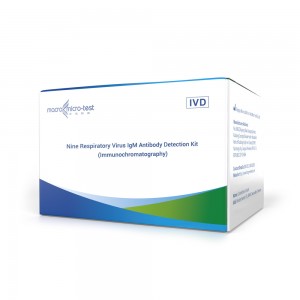



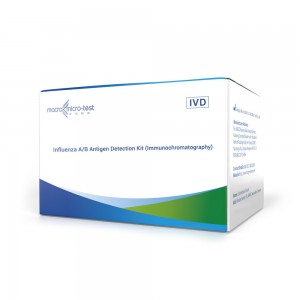
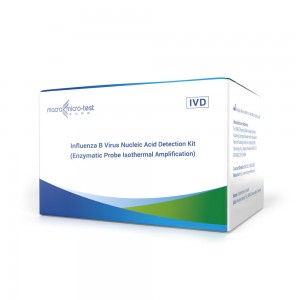



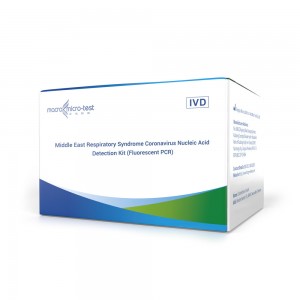


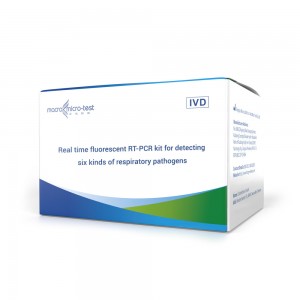
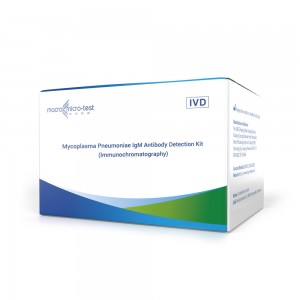
-300x300.jpg)